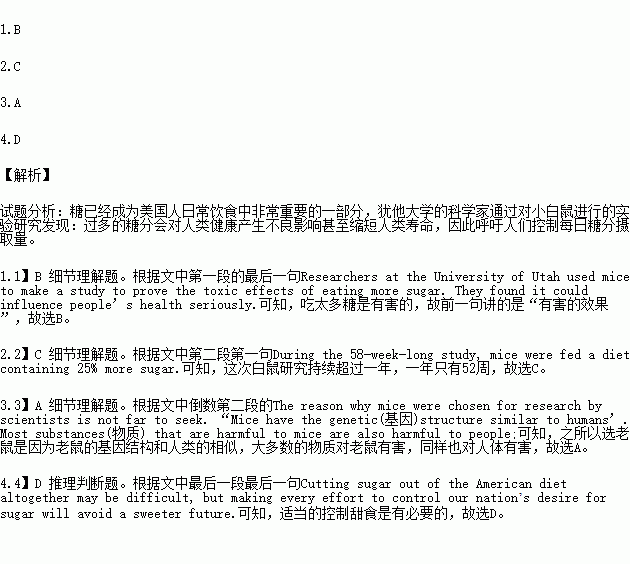ÌâÄ¿ÄÚÈÝ
We live in a sweet world. An average American kid consumes(ÏûºÄ) more than 20 teaspoons of sugar per day, and adults eat 50% more sugar today than they did in the 1970s. We all know that too much sugar isn¡¯t good for us. Researchers at the University of Utah used mice to make a study to prove the toxic effects of eating more sugar. They found it could influence people¡¯s health seriously.
During the 58-week-long study, mice were fed a diet containing 25% more sugar. This percentage is equal to a healthy human diet along with three cans of soda daily. The team found that these mice were twice as likely to die as mice without eating so much sugar. Though the mice did not show signs of obesity or high blood pressure, male mice produced 25% fewer offspring(ºó´ú) than the other mice.
The reason why mice were chosen for research by scientists is not far to seek. ¡°Mice have the genetic(»ùÒò) structure similar to humans¡¯. Most substances(ÎïÖÊ) that are harmful to mice are also harmful to people; it¡¯s likely that those important physical problems that cause the rising death rate among mice can also influence people,¡± says the study author James Ruff of the University of Utah. Findings from this study reveal negative effects that are not as detectable as weight gain or heart problems. Sugar can contribute to long-term changes in the body that can affect development and even shorten lives.
Different types of sugar have different effects on the human body. Some of the sugar we consume comes from foods we might expect¡ªcandy, soda, and cookies. But much of the sugar that we eat is hidden. Food companies add large amounts of sugar to items we may not classify as sweets. To help cut down extra sugar consumption, nutrition experts suggest looking at the ingredients on food packages. Cutting sugar out of the American diet altogether may be difficult, but making every effort to control our nation¡¯s desire for sugar will avoid a sweeter future.
1.The underlined word ¡°toxic¡± in Paragraph1 probably means ¡°________¡±.
A. positive B. harmful C. doubtful D. reasonable
2.According to Paragraph 2, we can know ________.
A. mice eating more sugar will live longer
B. the study on mice lasted less than a year
C. the study showed the bad effects of more sugar on mice
D. mice eating more sugar will become fatter and fatter
3.Why did the scientists choose mice to do the study?
A. Because a substance may have the same effects on mice and humans.
B. Because mice have a longer lifespan (ÊÙÃü) than other animals.
C. Because mice can take in the harmful substances easily and quickly.
D. Because mice are sensitive to the sweet taste.
4.It can be inferred from the last paragraph that ________.
A. sugar from candy, soda and cookies is helpful for us
B. we should never believe what food companies said
C. most types of sugar have similar effects on people
D. it¡¯s necessary to control people¡¯s wish for sugar

